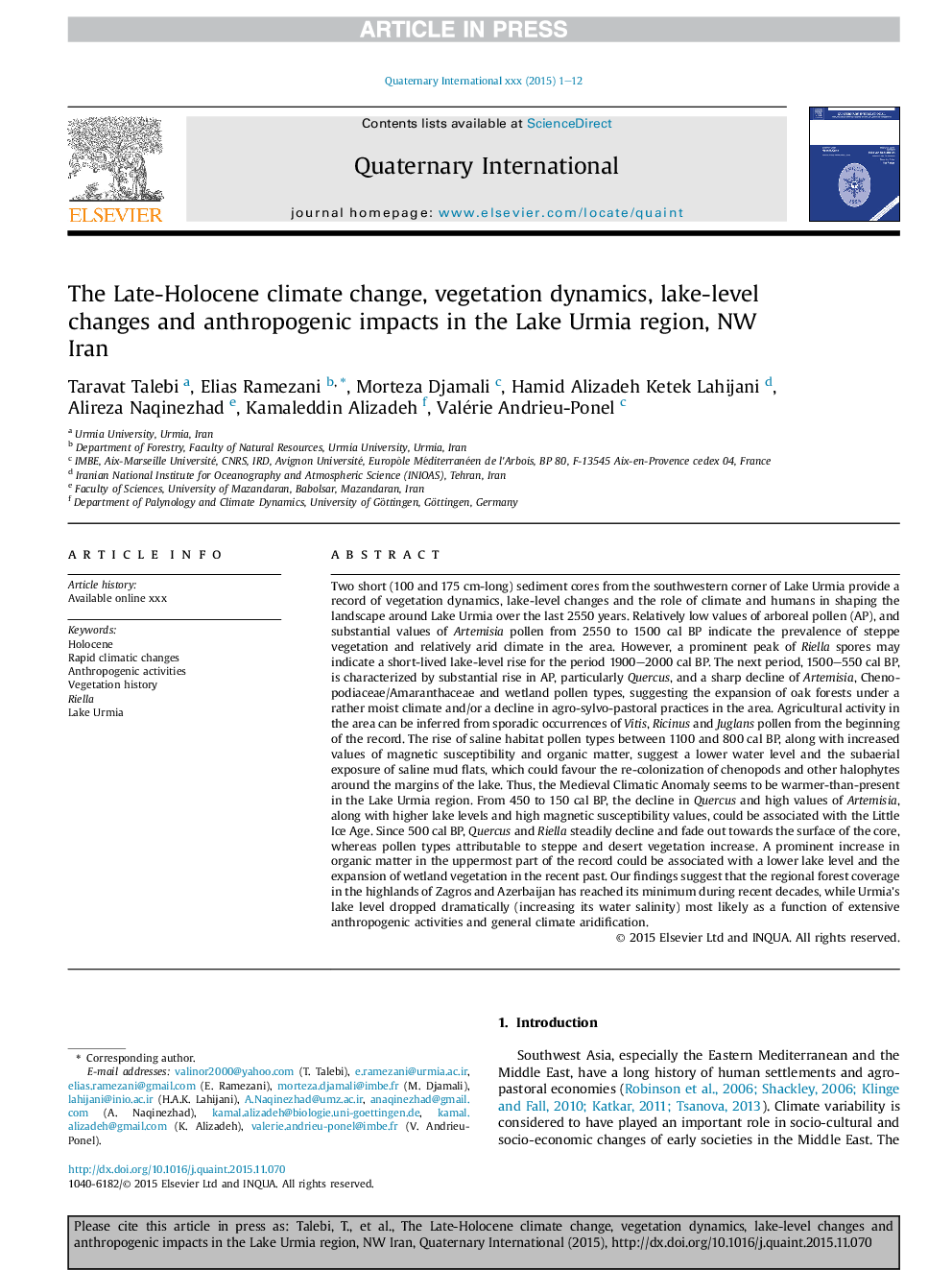| کد مقاله | کد نشریه | سال انتشار | مقاله انگلیسی | نسخه تمام متن |
|---|---|---|---|---|
| 10500868 | 944447 | 2016 | 12 صفحه PDF | دانلود رایگان |
عنوان انگلیسی مقاله ISI
The Late-Holocene climate change, vegetation dynamics, lake-level changes and anthropogenic impacts in the Lake Urmia region, NW Iran
ترجمه فارسی عنوان
تغییرات اقلیمی بعد از گلوتن، پویش گیاهی، تغییرات سطح دریاچه و تاثیرات انفجاری در منطقه دریاچه ارومیه، شمال غربی ایران
دانلود مقاله + سفارش ترجمه
دانلود مقاله ISI انگلیسی
رایگان برای ایرانیان
کلمات کلیدی
هولوسن، تغییرات آب و هوایی سریع فعالیت های انسان شناسی، تاریخ گیاه شناسی، ریللا، دریاچه ارومیه،
موضوعات مرتبط
مهندسی و علوم پایه
علوم زمین و سیارات
زمین شناسی
چکیده انگلیسی
Two short (100 and 175 cm-long) sediment cores from the southwestern corner of Lake Urmia provide a record of vegetation dynamics, lake-level changes and the role of climate and humans in shaping the landscape around Lake Urmia over the last 2550 years. Relatively low values of arboreal pollen (AP), and substantial values of Artemisia pollen from 2550 to 1500 cal BP indicate the prevalence of steppe vegetation and relatively arid climate in the area. However, a prominent peak of Riella spores may indicate a short-lived lake-level rise for the period 1900-2000 cal BP. The next period, 1500-550 cal BP, is characterized by substantial rise in AP, particularly Quercus, and a sharp decline of Artemisia, Chenopodiaceae/Amaranthaceae and wetland pollen types, suggesting the expansion of oak forests under a rather moist climate and/or a decline in agro-sylvo-pastoral practices in the area. Agricultural activity in the area can be inferred from sporadic occurrences of Vitis, Ricinus and Juglans pollen from the beginning of the record. The rise of saline habitat pollen types between 1100 and 800 cal BP, along with increased values of magnetic susceptibility and organic matter, suggest a lower water level and the subaerial exposure of saline mud flats, which could favour the re-colonization of chenopods and other halophytes around the margins of the lake. Thus, the Medieval Climatic Anomaly seems to be warmer-than-present in the Lake Urmia region. From 450 to 150 cal BP, the decline in Quercus and high values of Artemisia, along with higher lake levels and high magnetic susceptibility values, could be associated with the Little Ice Age. Since 500 cal BP, Quercus and Riella steadily decline and fade out towards the surface of the core, whereas pollen types attributable to steppe and desert vegetation increase. A prominent increase in organic matter in the uppermost part of the record could be associated with a lower lake level and the expansion of wetland vegetation in the recent past. Our findings suggest that the regional forest coverage in the highlands of Zagros and Azerbaijan has reached its minimum during recent decades, while Urmia's lake level dropped dramatically (increasing its water salinity) most likely as a function of extensive anthropogenic activities and general climate aridification.
ناشر
Database: Elsevier - ScienceDirect (ساینس دایرکت)
Journal: Quaternary International - Volume 408, Part A, 15 July 2016, Pages 40-51
Journal: Quaternary International - Volume 408, Part A, 15 July 2016, Pages 40-51
نویسندگان
Taravat Talebi, Elias Ramezani, Morteza Djamali, Hamid Alizadeh Ketek Lahijani, Alireza Naqinezhad, Kamaleddin Alizadeh, Valérie Andrieu-Ponel,
